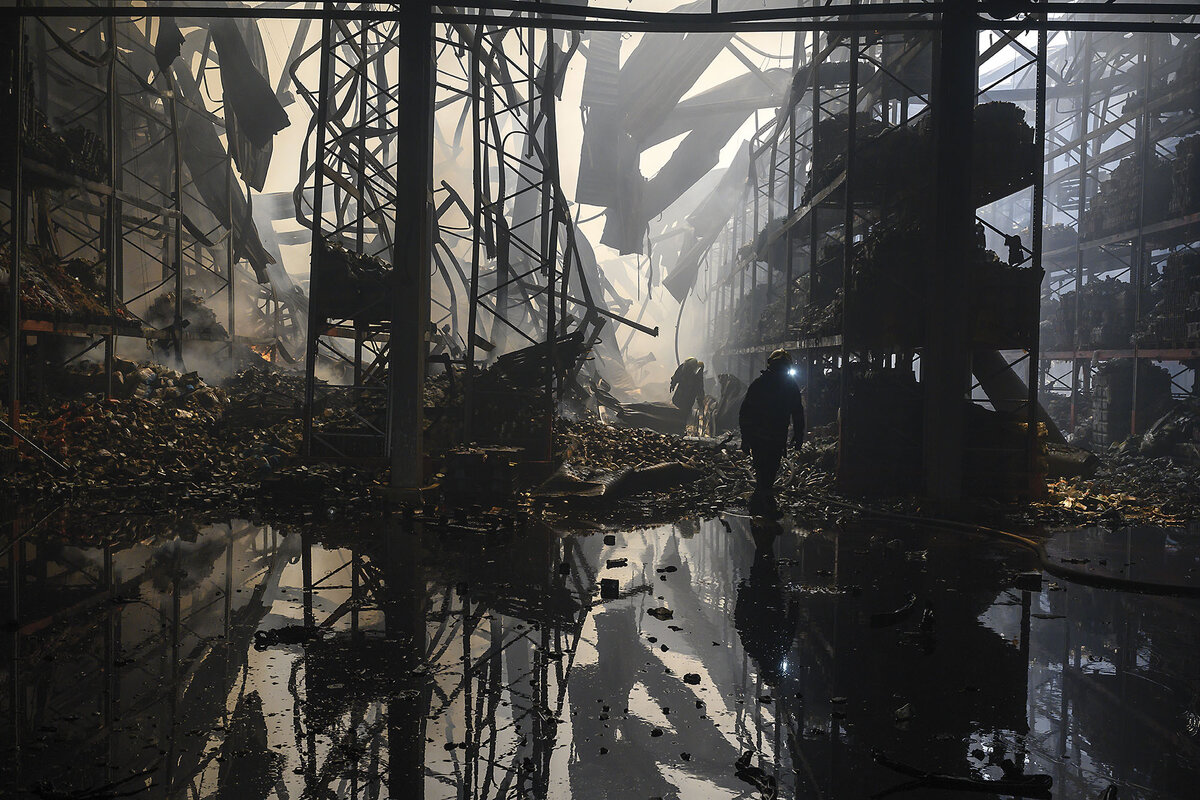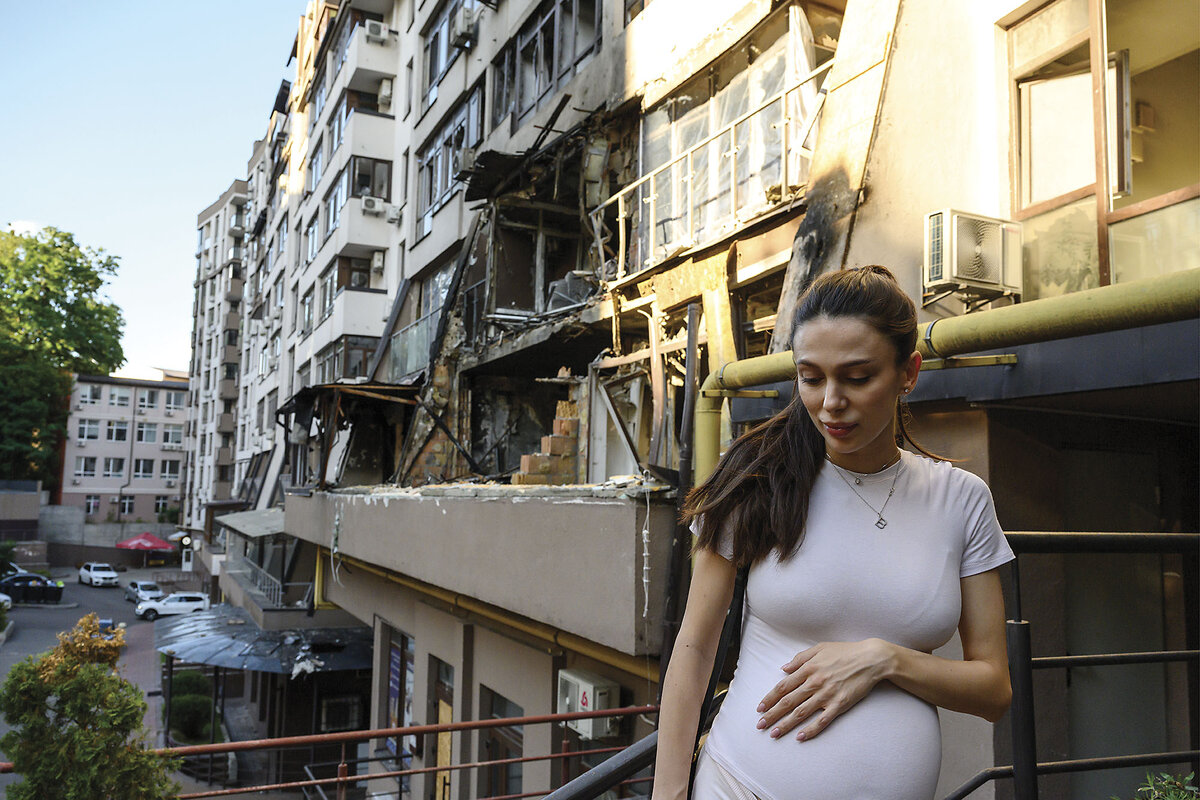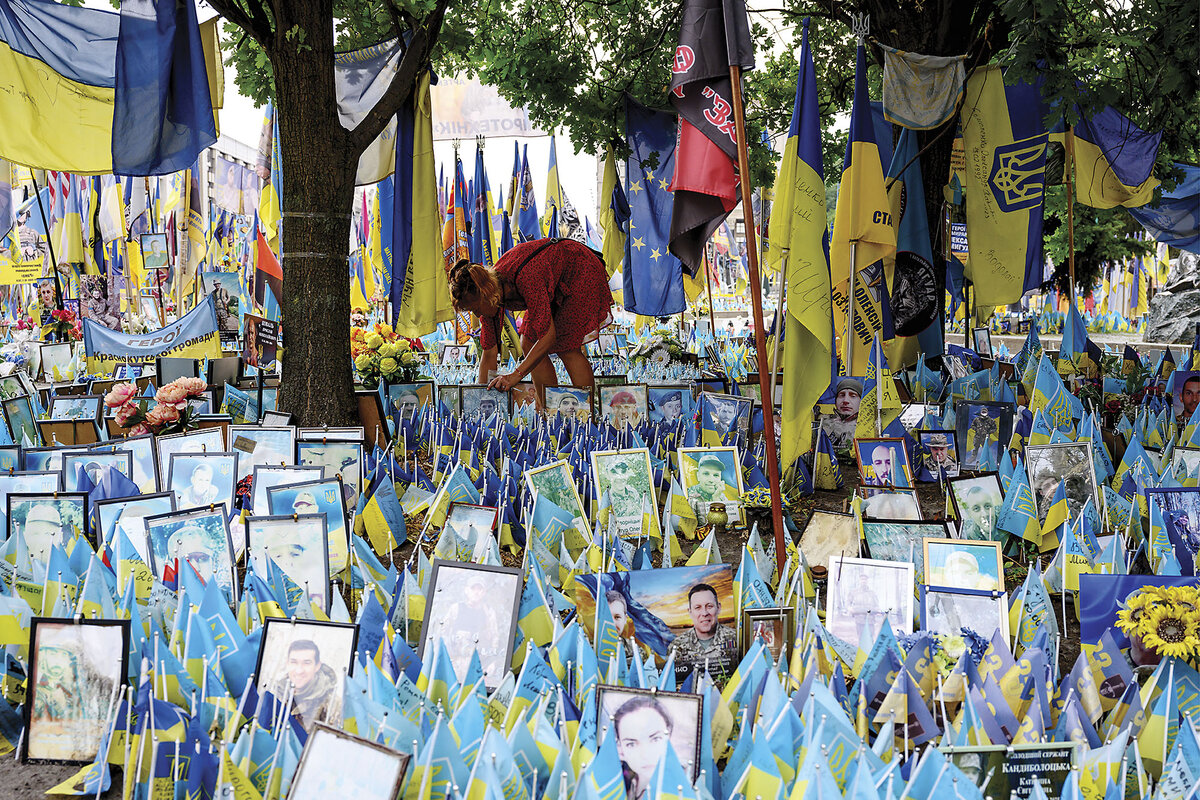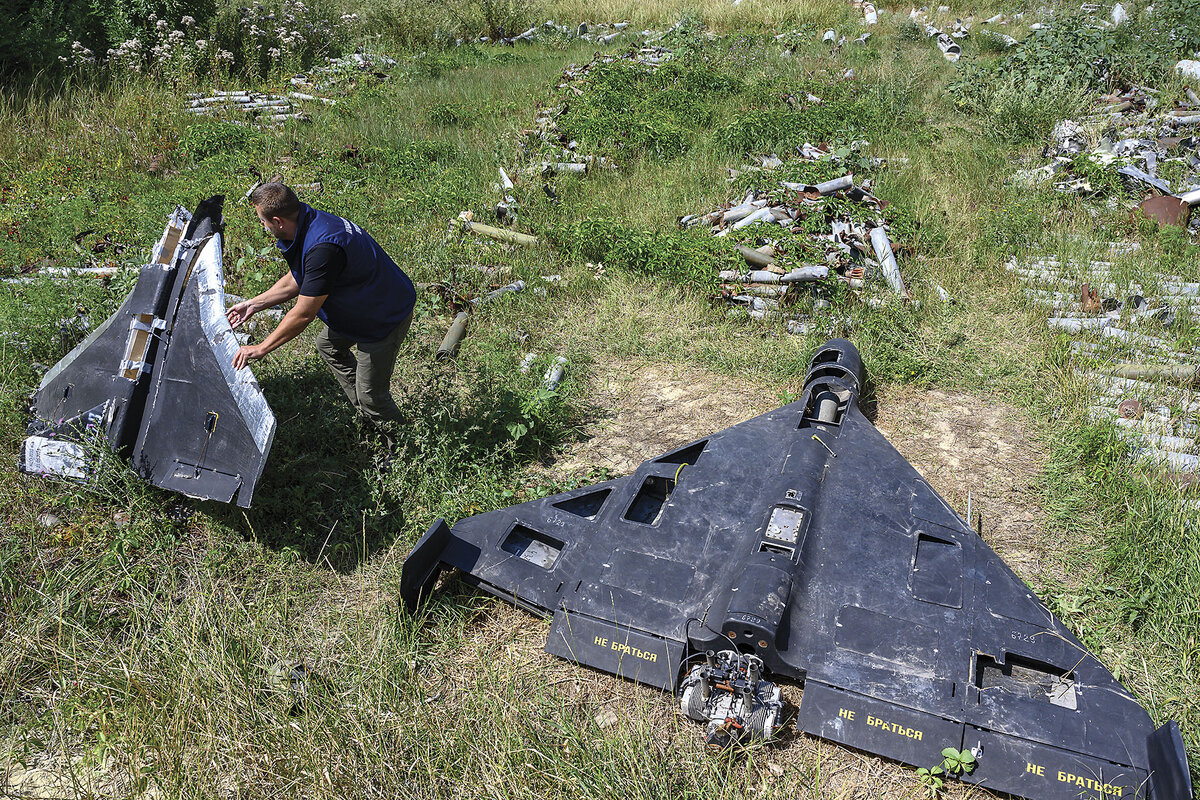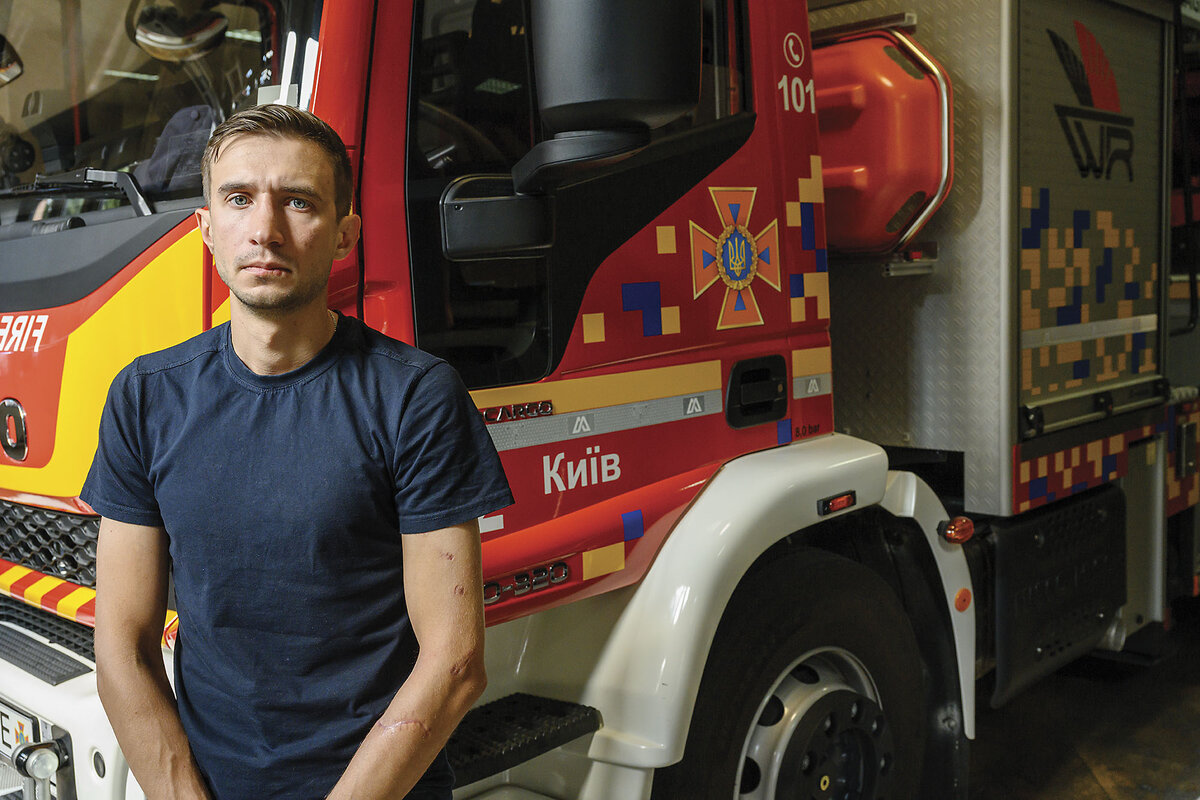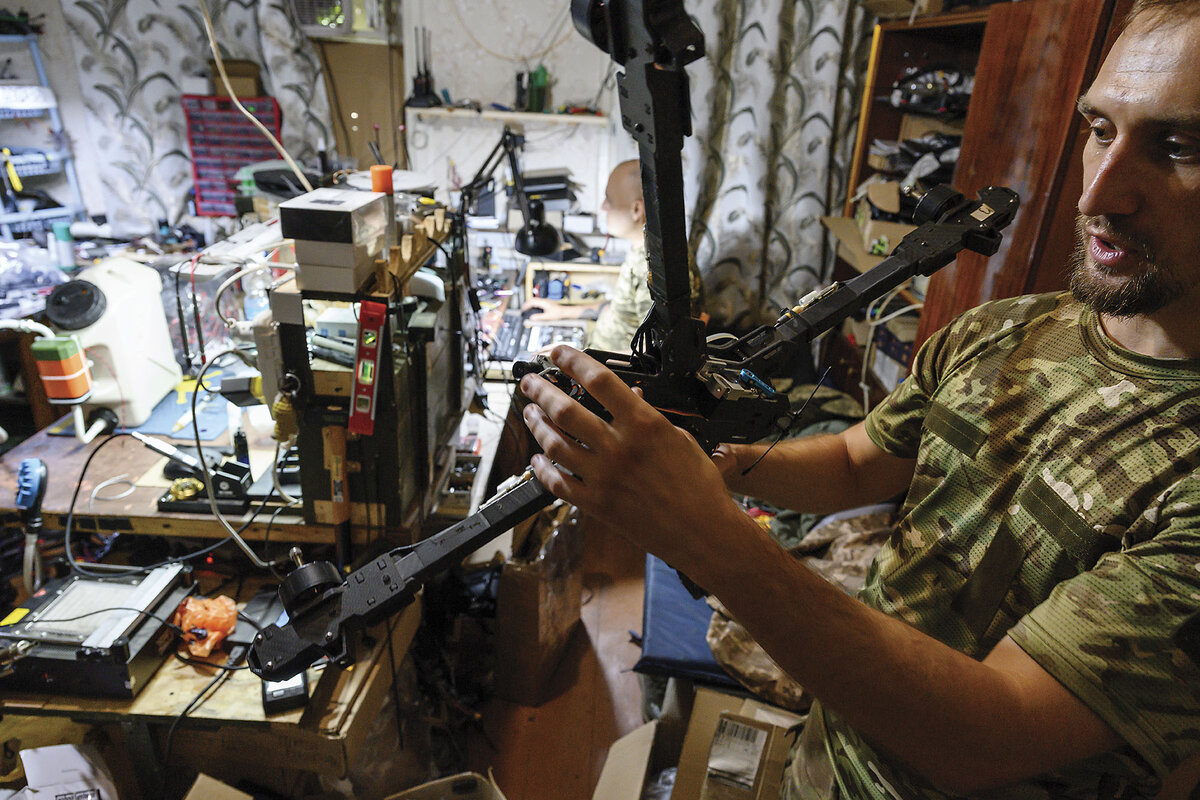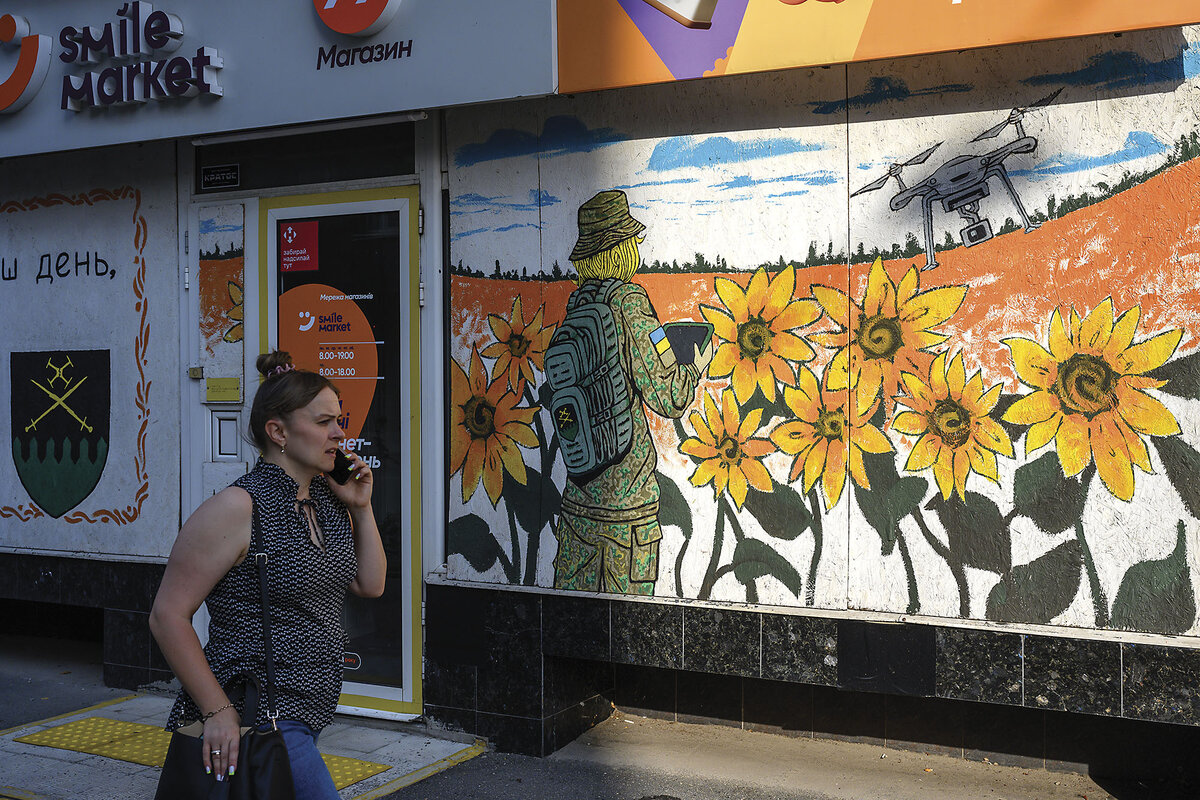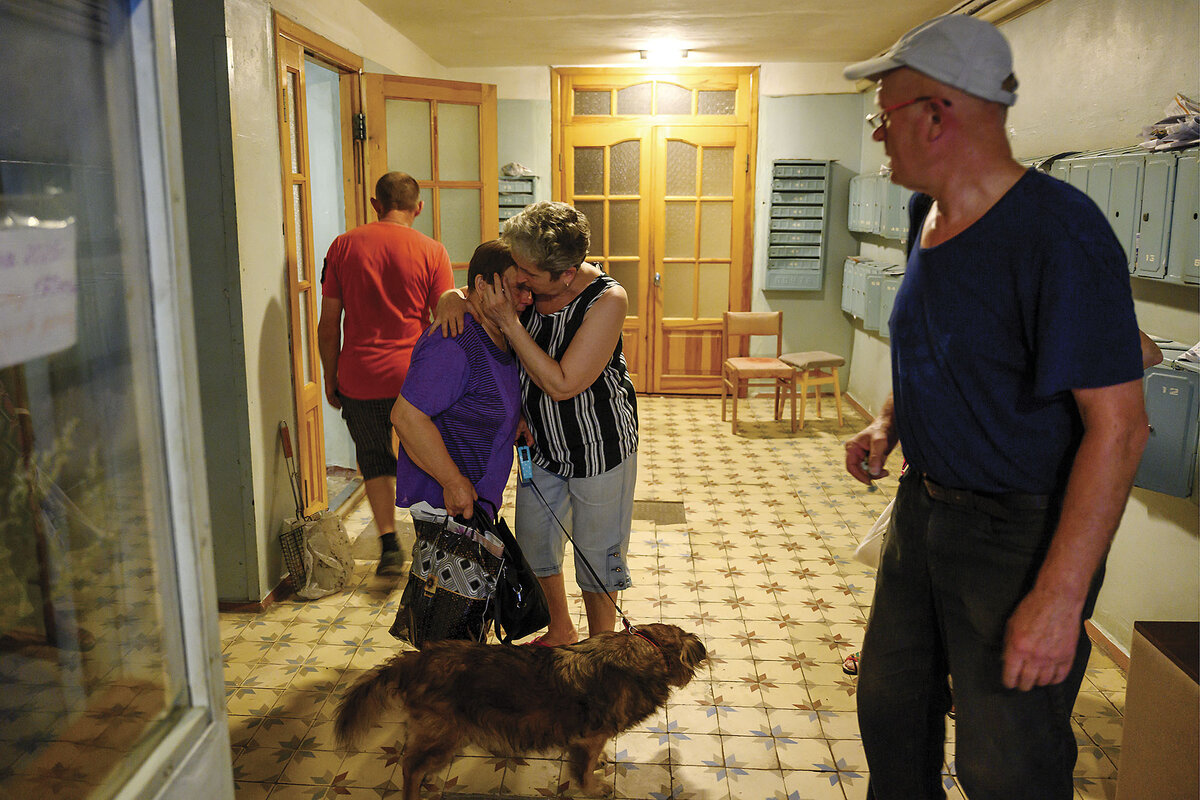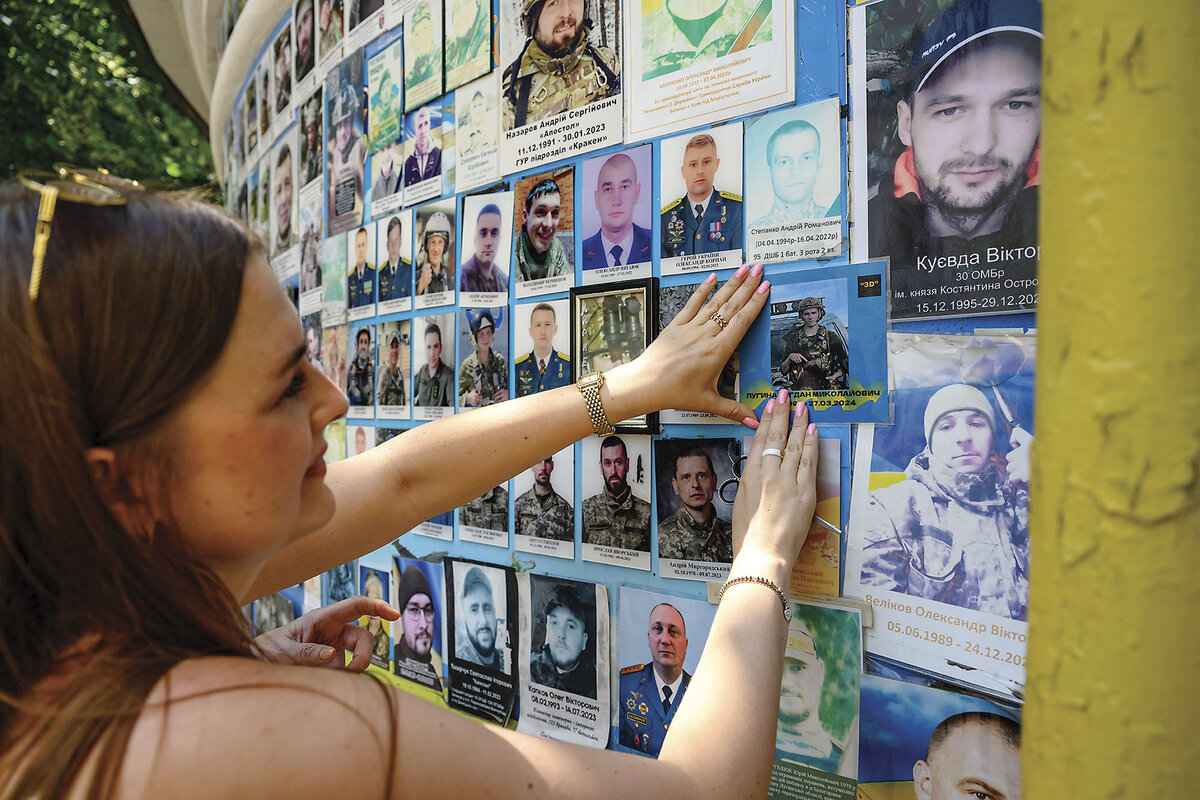In Ukraine, swarms of Russian drones and missiles are transforming combat
Loading...
| Kyiv and Kharkiv, Ukraine
As Ukrainian mother-to-be Bogdana Zhupanyna enters the apartment she owns in Kyiv, the acrid smell of smoke permeates her every pore.
She’s come to survey the wreckage wrought by a Russian drone. Everything is charred black, and the blast – made by just one Russian-made, Iranian-designed Shahed drone – blew the entire exterior wall of her apartment away, exposing the view several floors down to the parking lot.
Ms. Zhupanyna’s mother, who lived here, heeded the air-raid sirens and raced to a shelter just before dawn on July 21. Within an hour, the drone buzzed over Kyiv and slammed into her apartment – at once upending the lives of yet another family in Ukraine.
Why We Wrote This
As waves of Russian drones bring the front line directly to the Ukrainian people, the world is watching the future of modern warfare unfold.
As more apartments, civilian infrastructure, and military targets are subjected to increasingly intense and frequent barrages of drones, they provide raw insight into one of the most vexing challenges for Ukraine posed by Russia’s summer blitz. The country must defend against hundreds of drones and missiles launched in a single night.
“She lost everything,” says Ms. Zhupanyna of her mother, as she searches for anything to salvage. Her eyes brighten at the sight of several blackened but intact teacups. All the clothes are burned or too infused with smoke to keep.
On that night alone, Russia launched some 450 projectiles into Ukraine, including 200 Shahed drones, 24 missiles, and 200 Shahed-style decoys called Gerberas, according to the Ukraine air force.
A fragment of the drone wing sits on the bathroom shelf, a reminder of the destructive power of a single Shahed warhead.
Russia’s attack waves have brought the brutal bite of the front line to urban centers across the country like never before. Earlier in July, Russia launched 728 attack and decoy drones into Kyiv and other cities – a single nightly peak so far.
“Everyone saw the factories of drone production in Russia, so we expect this more and more,” says Ms. Zhupanyna, referring to a recent video on Russian state television of a production line churning out hundreds of the Russian-made version of the Shahed, known in Russia as Geranium, or Geran-2. “Unfortunately, I don’t see the end of this story.”
Yet, if Russia’s calculation is that Ukrainians will break under the increased pressure, and give up chunks of their country as Russia demands, there is little chance of that, says Ms. Zhupanyna. Her father was killed in the war after he volunteered to fight. A father of five, she recounts, he gave his life to “defend his nation.”
Her resolve against Russia is no less. “In our situation, we hate them. And when [attacks] happen, we hate them more,” says Ms. Zhupanyna, as she nears the due date for her baby girl. “It makes me more aggressive.”
And the gaping hole that was once Ms. Zhupanyna’s apartment? It is an aperture into how drones – cheap, now utterly ubiquitous, and ever more capable of delivering explosive payloads near and far – are changing the future of war.
Drones are crucial to both Russian and Ukrainian strategy
Since Russia’s all-out invasion of Ukraine 3 1/2 years ago, this conflict has been a laboratory of the dramatic changes in 21st-century warfare, which is increasingly defined by the wide spectrum of drone technology.
Today, drones deployed by both sides fight on the front line. They can ferry supplies and surveil enemy positions. They terrorize soldiers and civilians alike and attack and counterattack deep inside enemy territory.
Russia’s current surge in drone-led onslaughts appears aimed at undermining Ukraine’s morale and will to fight. On the actual front line, its soldiers make only incremental and costly gains.
Ukraine is countering with its own drone strikes deep inside Russia, targeting everything from oil refineries to weapons depots to strategic bombers. It aims to damage Russia’s ability to fight.
Little of that conforms to expectations when Russia first invaded, says Bohdan Danyliv, head of the military department of the Serhii Prytula Charitable Foundation, a Ukrainian organization that helps finance military advances.
“At the beginning, our Western partners thought they knew war,” says Mr. Danyliv, speaking in Kyiv. “It wouldn’t be new; it would be ‘old war,’ like the ’60s, ’70s, ’80s.”
Instead, new drone technologies have dictated swift progress away from traditional war-fighting. “The latest tanks costing millions of dollars can be destroyed by just two FPV drones costing $200,” he says, referring to smaller “first-person view” versions that provide on-location video. “Nobody was prepared for that.”
Two parallel drone wars are underway. The first is battlefield use of small FPV combat drones, which are radio-controlled or tethered by spools of fiber-optic cable.
These have expanded the front-line kill zone into a wide swath approaching 20 miles deep.
The second is the use of larger, long-range drones that Russia often uses to strike both military targets and civilian targets – like Ms. Zhupanyna’s apartment block.
Ukrainian President Volodymyr Zelenskyy has said Ukraine will produce 4 million drones this year, including 30,000 long-range drones. In late July, he set a goal of producing 1,000 drone interceptors per day to defend cities from current Shahed swarms.
“It’s a huge number, but a necessary number,” says Mr. Danyliv, who figures Ukraine now needs 10,000 drone interceptors each month, and likely many more.
“With all the help in the world, all that our partners could provide us immediately, we would still not be able to satisfy our needs in protecting the air with this huge amount of incoming drones,” says Kyryl Lyukov, head of unmanned technologies for the Serhii Prytula Foundation.
“It’s a battle of outsmarting the enemy,” he says. “We don’t have any choice. It’s not like this is some kind of pleasant creative process; it’s just a question of survival.”
Drone units make up just 2% of Ukraine’s armed forces. But Ukrainian commanders claim that their combat drones now account for one-third of all Russian soldiers killed, and one-quarter of all Ukrainian attacks – illustrating the scope of what drones can achieve.
But there are limits: Boots on the ground are still required, officers and analysts say, to take and hold territory. And drones now fly with, and against, modern warriors every step of the way.
Ukraine detects 50 “independent” drone attacks a day
Serhii Beskrestnov, call sign “Flash,” is head of the Ukrainian Center of Radio Technology and a drone analyst who works closely with the military.
“Every day, I see a change of tactics,” he says. “[The Russians] change the routes and the altitude. They are trying to find the optimal way to attack us.”
Key targets are infrastructure, to destroy power and heating capacity before winter, says Mr. Beskrestnov. Also key is Russia’s effort to “influence our civilian population, because, from the psychological point of view, our people every day listen to Shaheds.”
It gives the impression of looming “disaster,” he says. “I see Russia making a lot of experiments. ... It’s nonstop progress, a big problem for us.”
Already, Ukraine is detecting 50 attacks a day from “independent” Russian combat drones, which are “very, very dangerous,” says Mr. Beskrestnov. They are programmed to hunt and, on their own, strike military vehicles, groups of civilians, or any other prescribed target. Use of artificial intelligence is being fast-tracked.
Russia’s decoys, the Gerberas, don’t carry a warhead and are relatively primitive, made of Styrofoam, plastic, and wood. One Gerbera reportedly costs one-tenth the price of a Shahed. But they overwhelm Ukraine’s air defenses and make the same unnerving buzz as a Shahed. “It’s like terror of the civilian population,” says Mr. Beskrestnov.
“Probably Russia is waiting for the majority of people to say, ‘Mr. Zelenskyy, would you please stop the war? It’s very difficult to live 24/7 in this atmosphere,’” he says. Drones have “absolutely changed all war.”
Fostering fear as a weapon of war
In July, that was the same point made by Ukraine’s commander of unmanned forces, Robert Brovdi, a combat drone wizard with the call sign “Madiar,” who spoke at a security conference in Germany.
Russia’s President Vladimir Putin “has found the best cost-ratio solution for frightening civilians – it’s called Shahed. It has damaged our infrastructure a lot,” Mr. Brovdi told his audience.
“You remember, during the days when we were receiving 100 Shaheds per day, Putin was saying, ‘Hey, we will do 500,’ and we were laughing at this,” he continued. “But now there is no laughing in the room, as we average more than 400 per day.
“Our experience is super useful to all of you here,” he said, adding that no NATO country can defend a city attacked by 500 Shaheds each day for a week.
He recounted a visit last year to a large NATO base, where he was asked how vulnerable it was.
“Four of my battle crews, standing 10 kilometers [6 miles] away from this base, can destroy it fully in 15 minutes,” answered Mr. Brovdi. “It will look like Pearl Harbor during World War II.
“You should remember that all this technology is so cheap and easily acquired,” he said. “Only 10 terrorists can change anything in your country.”
Recognizing that dynamic, Russia has exponentially stepped up drone production and use in Ukraine. Russia now occupies some 20% of Ukrainian territory, but the 600-mile-long front line has barely moved since late 2022.
Russia’s growing drone emphasis is evident in a July 20 report on Russian state TV channel Zvezda, about the Alabuga factory, 600 miles east of Moscow.
The footage shows the production line of hundreds of black, triangle-shaped Geran-2 drone fuselages, formed of carbon fiber and fiberglass. After first using Iranian-made Shaheds in Ukraine in late 2022, Russia reportedly signed a $1.75 billion licensing agreement with Iran in early 2023 to produce its own variants.
The result is a growing arsenal of Geran-2 drones and Gerbera decoys, made at a factory that is expanding just as quickly. Satellite images from February showed just 15 buildings used as worker dormitories, CNN reported, though by mid-July a further 104 such buildings had been fully or partially built.
“At one time there was a plan to produce several thousand Gerans,” said Alabuga general director Timur Shagivaleev in the Russian report. “Now we produce nine times more than originally planned.”
On the factory floor are three large portraits of Soviet-era icons, including the architects of the Soviet nuclear weapons program and its space program. The third is of Josef Stalin, the Soviet leader infamous in Ukraine for orchestrating a famine that killed more than 3.9 million Ukrainians in the early 1930s.
These Soviet legends, the text tells workers, “live in your DNA.”
“People are tired”
Russia’s drones are having a profound impact on life in Ukraine.
Coffee cups at fuel stations are printed with a design of a drone in flames falling from the sky, and with the words, “Donate plus, drone minus.” Posted signs beside a cash register at a coffee shop display a drone and the words, “Death to enemies.”
A taxi driver in Ukraine’s western city of Lviv casually notes that a friend of his, a sales manager by day, volunteers every third night for a team that shoots down drones with machine guns. On his phone are pictures of his wife’s office building, struck by a Geran-2 in early July.
Graffiti and murals in the northeastern city of Kharkiv depict drones alongside assault rifles, as the tools of war. In one painting on the wall of a mini-market, a soldier operates a drone over a field of bright yellow Ukrainian sunflowers.
On the battlefield, a single drone unit can use 30 FPV drones in a day – numbers that run into the tens of thousands over time, but are not included in the tally of barrages of Geran-2 drones and decoys.
In July alone, Russia launched 6,297 of those bigger drones at Ukraine – an amount similar to all those used from January to October 2024, by one count, and a 1,378% increase from the previous July.
Fifteen of those drones were part of a late July Russian barrage that appeared to target an old, disused factory in Kharkiv, Ukraine’s second city, 20 miles from the border with Russia. That strike included two ballistic missiles and four glide bombs – hugely destructive Soviet-era dumb bombs, newly fitted with wings and guidance systems.
Significantly damaged was an apartment building and sports complex in an attack like nothing they had ever experienced, residents said.
Tamara Tiureva, the concierge of the building, describes a terrifying night huddled with neighbors in the lobby and stairwell, as explosions shattered glass and tore at the building edifice.
“Of course people are panicking and are afraid,” says Ms. Tiureva. She hugs a crying woman who joins the partial exodus with her husband and dog to safer parts of the city.
“It looks like there is no hope anymore,” says Ms. Tiureva, letting a few tears fall as she speaks. “We live here from one minute to another. You expect something to fall on you; our minds are already [messed] up,” she says. “As we see it, they just want to kill us all.”
City workers immediately replace the broken windows with plywood, and pave over one impact point in a road, in a well-practiced ritual. But the constant stress of Russia’s tactic is palpable.
“People are tired, they are more aggressive, and they have different reactions,” says Oleksandr Humaniuk, founder and head of the Ukrainian volunteer “Rose on Arm” search-and-rescue group in Kharkiv.
In the group’s basement offices, which are packed with armored protective vests, medical gear, and truck-mounted drone jammers, Mr. Humaniuk holds the plastic foam wing of a new Russian drone called Chernika, or Blueberry. It has a mechanism for moving wing flaps that is made in China.
Several of the small, maneuverable drones that carry just 5 to 7 pounds of explosives have been sent to Kharkiv. One struck a nearby construction crane.
“When the drone hit, literally 100 meters away there was a bar full of people with music, and they just kept sitting there like nothing happened,” recalls Mr. Humaniuk. “At the same time, 50 meters away, a young woman was sitting on the sidewalk, crying, panicking, and desperately asking to be taken home,” he says.
“We need a good tap on the back, so maybe this will backfire on the Russians,” says Mr. Humaniuk. “Because for quite some time there were no heavy strikes on Kharkiv, and people got distracted and relaxed, and some feel there is no war.
“These kinds of attacks remind them daily there is a war, and they get more active.”
“When the drones are done, they send missiles”
Among those most feeling the impact are Ukraine’s first responders. Firefighters in Kyiv deal with an average of five or six strike sites at a time, and sometimes as many as 20.
At every location, there is an enhanced risk of a “double-tap strike” – like the one that killed three Kyiv firefighters June 6. They responded to a drone strike, and within an hour a Russian missile struck the same site.
“This is a tactic, a pattern: When the drones are done, they send missiles – it happens every time now,” says Pavlo Petrov, a sinewy firefighter who survived the June 6 event and returned to work with shrapnel scars up and down his arms.
They respond to emergencies, he says, “knowing that the risk of a double tap has grown exponentially.”
Russia’s strikes are “not only backfiring” in Ukraine, but often increase public resolve not to give in, says Ihor Lysak, deputy head of this Kyiv fire station.
“My son is 3 years old, at nursery,” says Mr. Lysak. “At his small age, he knows the difference between an air alarm for a Shahed or a missile. At 3, he knows that Russia is responsible for this.”
“The only thing that we can see is Russia gaining more scorn and more hatred” from targeted Ukrainians, says Mr. Petrov. “I don’t want to advise the Russians, but if they think this will break us, it won’t work.”
“So when we see [Ukrainian] attacks back in Russia, it’s a kind of happiness,” he says. “Maybe you will think it is savage to say that, but this is how I see justice.”
Still, Ukraine’s escalating deep-strike attacks into Russia are about much more than revenge, says Inokentiy Razumov, a specialist in drone tactics with the military charitable foundation Come Back Alive.
“From Ukraine, our main targets are objects with strategic military value that are fueling the war machine of our enemy,” he says.
Recent successes include a Ukrainian drone strike on an oil refinery in the Samara region, some 500 miles east of the front line, on Aug. 2. In a video of the attack can be heard the sound of the drones, and the Russian gunfire that failed to stop them, and then a huge fireball appears.
More oil depots were struck July 24. A strategic Russian railway junction that is a key artery for the Russian military was targeted July 21.
One of the most dramatic deep-strike attacks came June 1, when Ukraine deployed 117 small FPV drones that were prepositioned in the roofs of trucks. The attack damaged 41 planes, including Russian strategic bombers, at four air bases as far as 3,600 miles from Ukraine. The Spider Web operation, mounted by the Security Service of Ukraine, had been 1 1/2 years in the making.
“Behind each such strike is planning, an operation by itself,” says Mr. Razumov. Targets include facilities that produce explosives or drone parts, or a fuel depot that, once struck, might halt fuel supplies to all Russian forces on a specific part of the front line for a month. “There are whole teams working, analyzing, and trying to predict the effectiveness of that.
“Deep strike has a very complex effect on the enemy,” says Mr. Razumov. “By bringing the war deep into enemy territory, we are able to interfere with the enemy’s planning.”
Why boots on the ground still matter
Not far from the front line of eastern Ukraine, military drone experts of Ukraine’s 77th Separate Airmobile Brigade are assembling and modifying combat drones to use against Russian units.
Wedged into a cramped electronics workshop surrounded by wire cutters, soldering irons, and hair-thin fiber-optic cable, drone specialists sing the praises of this ever-improving tool of war. They work nearly nonstop.
“The effectiveness of drones dictates what is going on on the battlefield,” says the head of the workshop, a rocket specialist and computer engineer who gives the name Artem, call sign “Raketa.”
“It’s not only about strike drones; it’s also about logistics, evacuations,” he says, as fellow engineers fashion the insectlike units. “Drones can bring food, can bring ammunition. The most important is surveillance: The moment we see movement of the enemy in our zone, the FPV strike drone flies out and destroys everything.”
And yet, even here, where the disparity between these drones’ low cost and their ability to slay far more expensive military platforms is an article of faith, there is recognition that drones alone can’t win the war.
“Unfortunately, only the human being existing, boots on the ground, makes it possible to claim territory, to say you control it,” says Artem.
“With drones, you can clear up to 30 kilometers [18.6 miles] of territory, but the Russians can make another assault and come in and take positions,” he says. “Drones can’t hold those positions. Drones can’t perform tasks that infantry can perform. So we still have to have people in trenches on the ground.” Nevertheless, drones are an integral part of any effective fighting force that will take and hold ground.
“The game changer will still be infantry,” but only if all elements work together, says Mr. Danyliv of the Serhii Prytula Foundation. That means infantry has to work with surveillance drones and be protected by FPV drones.
Deep strikes are required to damage Russian logistics. And strikes should be made on Moscow and St. Petersburg “to control somehow their appetite to continue the war,” Mr. Danyliv says.
Those calculations matter little to one Ukrainian family that moved to Kyiv for safety a month ago from Sumy, the northeast city closest to the Russian border and a focus of Russian attacks.
At a memorial wall in Kyiv plastered with images of Ukrainian soldiers lost in the conflict, Olena Leontieva adds a picture of her cousin, Bohdan Luhina, killed in action in the Donetsk region last year, and another of a close friend of his.
Ms. Leontieva left Sumy with her 8-year-old daughter, but the front line of Russia’s drone war found them in Kyiv. The nights they spend in bomb shelters here, she says, are “much, much more scary” than in Sumy.
“The Russians are just trying to make people afraid, and to break them. But all the people who are afraid have left already,” says Ms. Leontieva, with a wry smile.
Russia, she says, “attacked the wrong people.”
Reporting for this story was supported by Oleksandr Naselenko.



